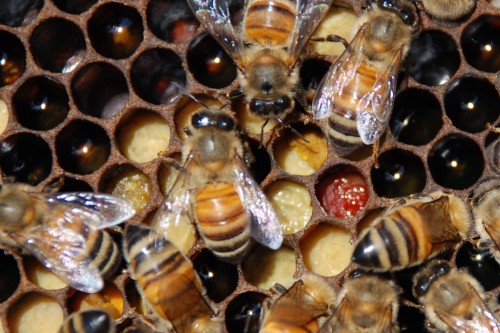by Paige Wiren
Chronic back pain? Inflammation? One Utah beekeeper says his bees can provide alternative, effective relief with no side-effects.
When people talk about bee stings it’s usually about how to treat the area that’s been stung, but a more unusual and curious conversation revolves around how to treat an area of the body with a bee sting, turning the proverbial victim into willing participant.
Bee sting, or bee venom therapy is the intentional application of a live honeybee to a specific target on the body, the objective being to prompt the bee to sting the subject so that the person receives a dose of venom.

Apitherapy is the general term used to denote the medicinal use of bee products, but the word is often associated with the particular practice of bee venom therapy. Like so many other kinds of natural therapies, apitherapy is not a newly developed form of treatment. Doctors in China have been treating patients for, and this is what we read all the time, thousands of years. And, as is also true with western developments of millennially-tested medical practices, there were a few American doctors that explored apitherapy in the 19th and 20th centuries, but, also typical, it never was adopted by mainstream medicine.
Fast forward to the 21st century, where modern technology allows us to access and share information about ancient ways, a coupling of factors that explains the resurgence of the practice of bee venom therapy. In fact, fast forward to the 21st century to Pleasant Grove, Utah, where bee keeper Neil Shelley lives and raises hives.
An avid lay entomologist, Shelley decided seven years ago to try keeping bees, a hobby that has grown into a cottage industry and experimental practice. Through his business, Wild Attitude Apiaries, Shelley sells bee products, such as honey, pollen and propolis, as well as his all-natural, made-to-order lotions, lip balms and soaps. The other service he offers is bee venom therapy.
Neil, a curious academic, has been administering stings for two years.
“I don’t proclaim something unless I’ve seen it firsthand or experienced it firsthand,” Shelley affirms, and he has done both.
Used historically for treating chronic inflammatory disorders, Neil has applied stings to people suffering from bursitis, which, he says, “has been very successful,” and has stung people with arthritis, “with mixed results.”
He also employs venom for alleviating his own back pain, noting that when the sting is applied at night he wakes up the next morning pain free.
Cursory internet research yields descriptions of the therapeutic use of bee venom that say “apitherapy claims to…,” and “all accounts are anecdotal.” If a treatment works, it works, whether the medicine has been scientifically studied and medically proven, or has demonstrated successful outcomes documented in a collection of empirical stories.
Apitherapy is not FDA approved, nor are pharmaceutical companies clambering to fund research. Why?
“You can’t patent bee venom so there’s no profit in it for the drug companies,” Shelley matter-of-factly answers.
The active component in bee venom is mellitin, an anti-inflammatory, which is why it is used to treat inflammatory as well as auto-immune disorders and chronic pain. Bees’ venom will have different potencies in relation to the seasons.
“Your bees going into the fall, from the late summer hatch are going to be ‘hotter’ because their venom is more powerful,” Shelley explains. So, too, will the environment’s available forage. Since a bee’s venom is the insect’s defense mechanism, it makes sense that those that need to compete more for food will cultivate a more effectual chemical weapon.
The stinging process is relatively simple. After Neil identifies where on the subject the sting will be applied, he collects bees in a small, modified mason jar.
“When bees hit a certain age, they’re assigned different functions. I want forager or guard bees from outside the hive, because they’re older and their venom is more effective.”
He then uses reverse tweezers to pick a bee from the jar, positions the insect over the identified point, and gently pushes the bee’s abdomen. The pressure produces an automatic sting response and the barb penetrates the skin pulsing venom into the epidermis. For good measure, Neil squeezes on the gland on the exposed tip of the stinger to make sure all the venom is used.
“I leave it alone for about five minutes, because that’s how long it takes for the mechanism to deliver the venom.”
Neil then removes the stinger and humanely disposes of the bee since in losing the stinger the bee will “bleed out.” (Bees have hemolymph, an invertebrate fluid equivalent to human blood, but bees have an open circulatory system.)
“Most people will spend more time getting worked up about how much it’s gonna hurt than how much it actually hurts.” But it’s not pleasant. “It’s like being pierced by a really fine needle, or kind of like a stinging nettle, only much more intense.” §


